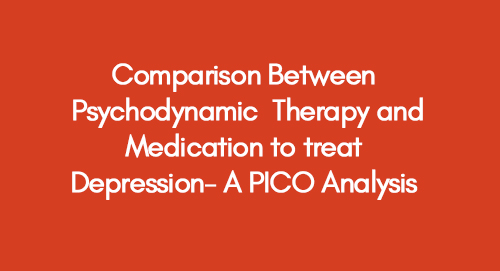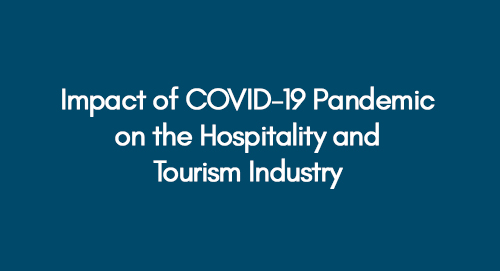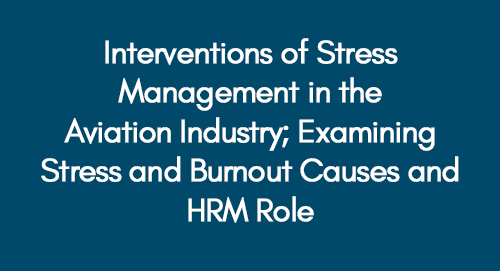
How Does the Use of Psychodynamic Therapy in Comparison to Medication Help in Treating Depression in Teenagers? A PICO analysis
June 2, 2022
Impact of COVID-19 Pandemic on the Hospitality and Tourism Industry
June 2, 2022Stress management in the aviation industry involves interventions like Employee Assistance Programs, flexible work arrangements, and ongoing training to address causes such as operational pressure. Human Resource Management (HRM) is key in implementing these measures, ensuring a supportive workplace culture that safeguards employee well-being and operational effectiveness.
The aviation industry operates as a sophisticated network of interconnected systems, with human factors serving as linchpins for safe and efficient operations. Within this complex environment, pilots, air traffic controllers, and ground personnel operate under considerable pressure, navigating challenges beyond flight's mechanical aspects. The cumulative effects of stressors inherent in the industry, ranging from stringent regulations to irregular work schedules, create a fertile ground for burnout. Recognizing the potential consequences of unchecked stress and burnout, it becomes imperative to explore and implement effective interventions to safeguard the mental well-being of aviation professionals and the integrity of their operations.
In this context, Human Resource Management (HRM) emerges as a central player in mitigating the impact of stress and burnout within the aviation industry. HRM is uniquely positioned to understand the multifaceted nature of stressors affecting employees and can devise strategies to foster a resilient and supportive work environment. This blog delves into the root causes of stress and burnout in the aviation sector, shedding light on personnel's unique challenges. Moreover, it emphasizes HRM's critical role in developing and implementing targeted interventions, thereby underlining the significance of proactive human resource practices in ensuring the long-term well-being and effectiveness of the industry's workforce.
Research Proposal
This research proposal outlines a study on stress management interventions within the aviation industry. The investigation aims to explore the causes of stress and burnout, particularly emphasising the role of Human Resource Management (HRM) in implementing effective stress management strategies.
Introduction
Santos and Melicio (2019) assert that workplace stress is pervasive across organizations and individuals, necessitating effective stress management. In today's world, workplace stress has increased as organizations often rely on a limited workforce to handle extensive responsibilities. The authors highlight the inadvertent damage caused by organizations expecting employees to exceed their capabilities, leading to diminished confidence, irritability, and withdrawal (Tomic and Liu, 2017). However, Hajiyousefi, Asadi, and Jafari (2017) argue for considering individual abilities to ensure effective workload management, refuting the notion of workplace stress as merely a phrase coined by those evading responsibilities.
Emphasizing the importance of individuals mastering workload management, Tripathi, Joshi, and Sharma (2020) assert that a clear understanding of tasks contributes to becoming an asset to the organization. Eriksen (2019) identifies burnout and stress as key facets of workplace stress, attributing stress to a lack of autonomy, support, opportunities, and appreciation. Conversely, burnout results from a negative outlook, emotional exhaustion, and an overall adverse response to stressors (Stokes and Kite, 2017; Eltorai, 2018). The aviation industry has recently faced notable stress and burnout challenges, prompting the human resource department to play a crucial role in addressing these issues.
Literature Review
A targeted review of credible research articles was conducted to assess stress management in the aviation industry. Rodriguez-Paras, Khanade, and Sasangohar's (2018) study highlights the aviation sector as particularly susceptible to high levels of workplace stress, necessitating attention from the human resource departments of industry organizations. Stress and burnout emerge as primary concerns in aviation, with Foy et al. (2019) underscoring their detrimental impact on employee focus and potential. Carrillo et al. (2018) note the industry's diverse workforce, with distinct stressors affecting airline pilots, cabin crew members, and air traffic service workers.
Airline pilots grapple with stress related to job demands, resource allocation, the pursuit of job crafting and happiness, and training performance (Cachia and Whitfield, 2018). Cabin crew members face stress and burnout from extended working hours and insufficient rest, while air traffic service workers experience continuous mental strain (Smith, Dyal, and DeJoy, 2019; Rook et al., 2018). Lockwood, Henderson, and Stansfeld (2017) emphasize the pivotal role of the human resource department in resolving these challenges and advocating for effective stress management strategies. It is incumbent upon HR to formulate and enact strategies that address workplace stress, ensuring the well-being of employees in the aviation industry.
Research Objectives
The research endeavours to investigate the origins of stress and burnout within the aviation industry, with a specific focus on the involvement of HRM in addressing these issues. The research objectives are outlined as follows:
- Analyzing workplace stress and its theoretical underpinnings.
- Identifying pivotal factors contributing to workplace stress and burnout in the aviation sector.
- Conducting a critical examination of HRM's role in alleviating workplace stress and minimizing burnout within the aviation industry.
- Offering recommendations for effective stress management in the workplace, aimed at reducing burnout and enhancing overall productivity within the aviation sector.
Research Questions
Derived from the principal objectives of this study, the research questions are formulated as follows:
- What factors contribute to workplace stress?
- What are the significant elements leading to workplace stress and burnout in the aviation industry?
- How does HRM contribute to alleviating workplace stress and minimizing burnout within the aviation industry?
- What recommendations can be proposed to mitigate workplace stress and reduce burnout in the aviation industry, ultimately enhancing productivity?
Methodology
The research methodology encompasses crucial components aimed at acquiring precise and reliable data. The chosen research philosophy is interpretivism, as emphasized by Ghauri, Grønhaug, and Strange (2020), aligning with analysts who prioritize interpreting study elements. Given the study's focus on stress, burnout, and HRM in the aviation industry, a qualitative research approach, particularly the inductive approach, is selected. Inductive reasoning, as described by Lindlof and Taylor (2017), complements the interpretivist philosophy, allowing the researcher to analyze the research aim and objectives based on existing and relevant information.
The research strategy adopted is grounded theory, which facilitates the creation of a theory derived from participant data. Walliman (2017) and Litosseliti (2018) affirm that grounded theory is instrumental in identifying and addressing issues in the research field. Qualitative interviews are the chosen investigative method, offering face-to-face interaction to gather firsthand, verified information. The study specifically targets cabin crew members from Qatar Airways, selecting 10 individuals from diverse cultures and nationalities to gain comprehensive insights into the causes of stress and burnout. Additionally, an interview with the HR manager aims to provide valuable perspectives on implemented practices to address workplace stress. Thematic analysis will be employed for data analysis, focusing on patterns and key themes to effectively answer the research aim and objectives.
Review the following:
- Dissertation topic and outline writing
- Dissertation proposal writing service
- Dissertation chapter writing
Expected Outcomes
The anticipated outcome of this study is to provide a foundation for future researchers to explore the interventions of stress management in the aviation industry, particularly the involvement of HRM. By focusing on interviews with cabin crew members, the study opens avenues for future analysts to investigate stress and burnout issues from the perspectives of other employees within the aviation sector. Incorporating theoretical and empirical data enhances the quality of information collected, facilitating a more comprehensive assessment for future research endeavours. 

The timeline is structured into nine phases. In the initial phase, the topic selection is completed during week 1. Subsequently, the second phase, which entails refining and finalizing the chosen topic, occurs in week 2. Weeks 3 and 4 are dedicated to researching the selected subject and drafting a comprehensive proposal. The subsequent weeks, 5 and 6, are designated for developing the literature review chapter. Moving forward, week 7 focuses on the critical stages of data collection and analysis. The data collection phase is executed in week 8, followed by an intensive data analysis process spanning weeks 9 and 10. The final phase involves crafting the conclusion, which is accomplished in week 10.
Drop us a message on WhatsApp or by Email if you want to access the complete report of the above article. We will get back to you within 24 hours.
Conclusion
In conclusion, this research explores the causes of stress and burnout in the aviation industry and HRM's role. Grounded in interpretivism, the study employs qualitative interviews with cabin crew at Qatar Airways. The anticipated outcome is to contribute insights for future research while the systematic timeline ensures a thorough investigation, culminating in a comprehensive conclusion by week 10. The findings are expected to provide actionable recommendations for stress management in the aviation sector.
References
Bernard, H.R., 2017. Research methods in anthropology: Qualitative and quantitative approaches. Rowman & Littlefield.
Bryman, A., 2016. Social research methods. Oxford University Press.
Cachia, M. and Whitfield, M., 2018. How does workplace stress affect job performance? An employee's perspective. New Vistas, 3(2).
Carrillo, E., Freeman, L.L., Morand, D., Ocampo, R., Afegbua-Sabbatt, R. and Clayton, R., 2018. EXAMINING THE IMPACT OF EMOTIONAL INTELLIGENCE ON WORKPLACE STRESS. International Journal of Management and Human Resources, 6(1), pp.64-83.
Eltorai, A.S., 2018. Lessons from the sky: an aviation-based framework for maximizing the delivery of quality anaesthetic care. Journal of Anesthesia, 32(2), pp.263-268.
Eriksen, C., 2019. Managing Work and Relationships at 35,000 Feet: A Practical Guide for Making Personal Life Fit Aircrew Shift Work, Jetlag, and Absence from Home. Routledge.
Foy, T., Dwyer, R.J., Navarrete, R., Hammoud, M.S.S. and Rockett, P., 2019. Managing job performance, social support and work-life conflict to reduce workplace stress. International Journal of Productivity and Performance Management.
Ghauri, P., Grønhaug, K. and Strange, R., 2020. Research methods in business studies. Cambridge University Press.
Hajiyousefi, H., Asadi, H. and Jafari, A., 2017. Work Stress among Flight Attendants; The Perspective of a Standard Sports Examination Designing as a Prerequisite to Flight License. International Research Journal of Applied and Basic Sciences, 11(1), pp.31-40.
Lindlof, T.R. and Taylor, B.C., 2017. Qualitative communication research methods. Sage publications.
Litosseliti, L. ed., 2018. Research methods in linguistics. Bloomsbury Publishing.
Lockwood, G., Henderson, C. and Stansfeld, S., 2017. An assessment of employer liability for workplace stress. International Journal of Law and Management.
Rodriguez-Paras, C., Khanade, K. and Sasangohar, F., 2018, September. Stress Detection techniques in different work domains. In Proceedings of the Human Factors and Ergonomics Society Annual Meeting (Vol. 62, No. 1, pp. 1704-1706). Sage CA: Los Angeles, CA: SAGE Publications.
Rook, C., Hellwig, T., Florent-Treacy, E. and Kets de Vries, M., 2018. Workplace stress in senior executives: coaching the “uncoachable. International Coaching Psychology Review.
Santos, L.F. and Melicio, R., 2019. Stress, Pressure and Fatigue on Aircraft Maintenance Personal.
Smith, T.D., Dyal, M.A. and DeJoy, D.M., 2019. Workplace stress and firefighter health and safety. In Increasing Occupational Health and Safety in Workplaces. Edward Elgar Publishing.
Stokes, A.F. and Kite, K., 2017. Flight stress: Stress, fatigue and performance in aviation. Routledge.
Tomic, I. and Liu, J., 2017. Strategies to overcome fatigue in air traffic control based on stress management. Int. J. Eng. Sci., 6(4), pp.48-57.
Tripathi, S., Joshi, D. and Sharma, A., 2020. To Study the Various Techniques Required To Overcome Workplace Stress among the Employees. Studies in Indian Place Names, 40(3), pp.469-479.
Walliman, N., 2017. Research methods: The basics. Routledge.
Get 3+ Free Dissertation Topics within 24 hours?


















 Download PDF File
Download PDF File








